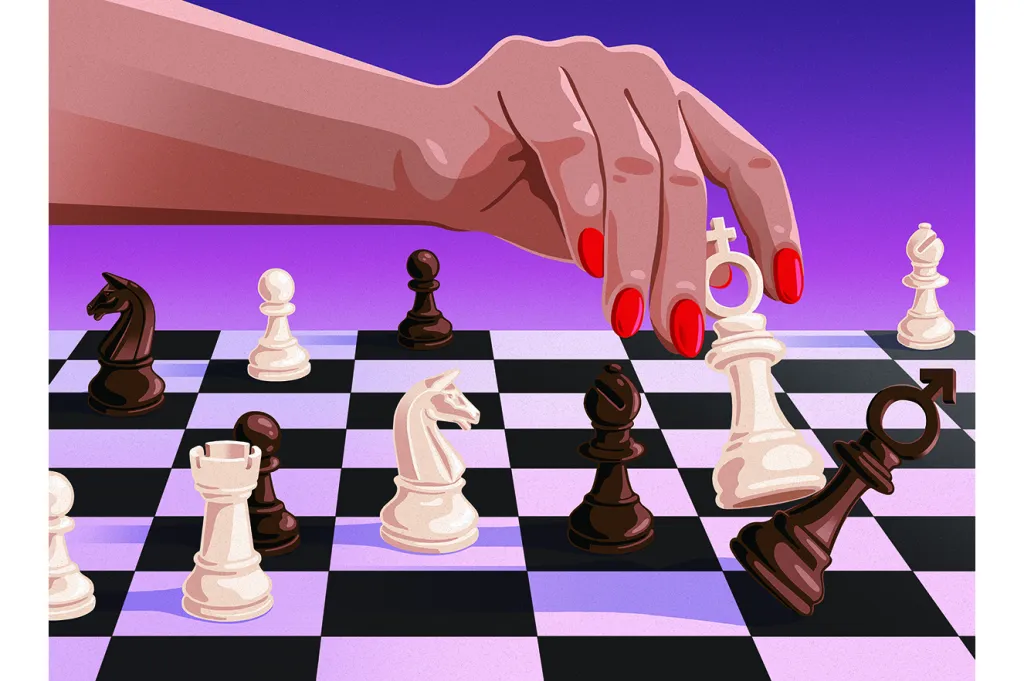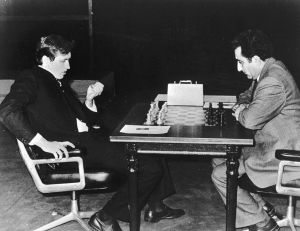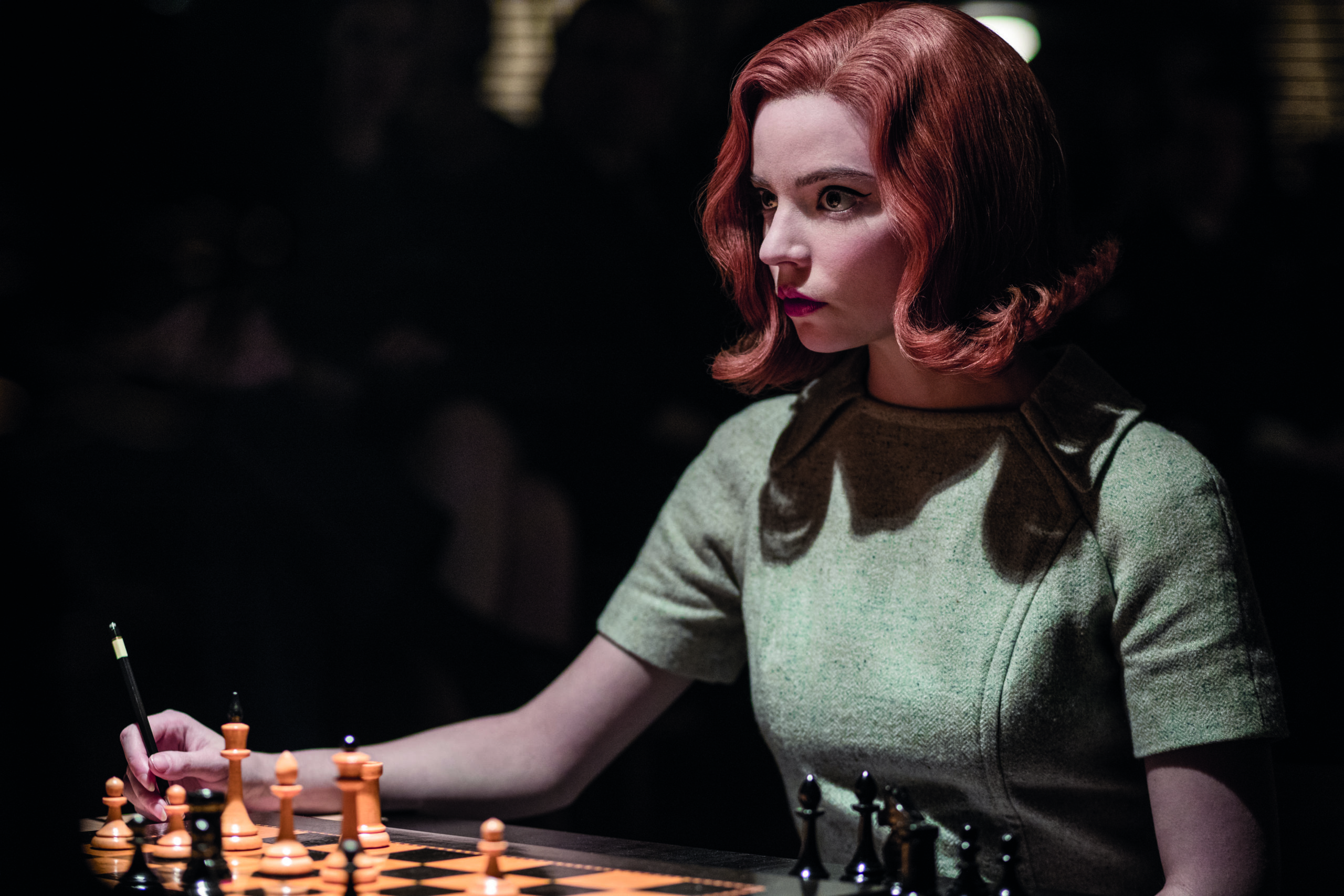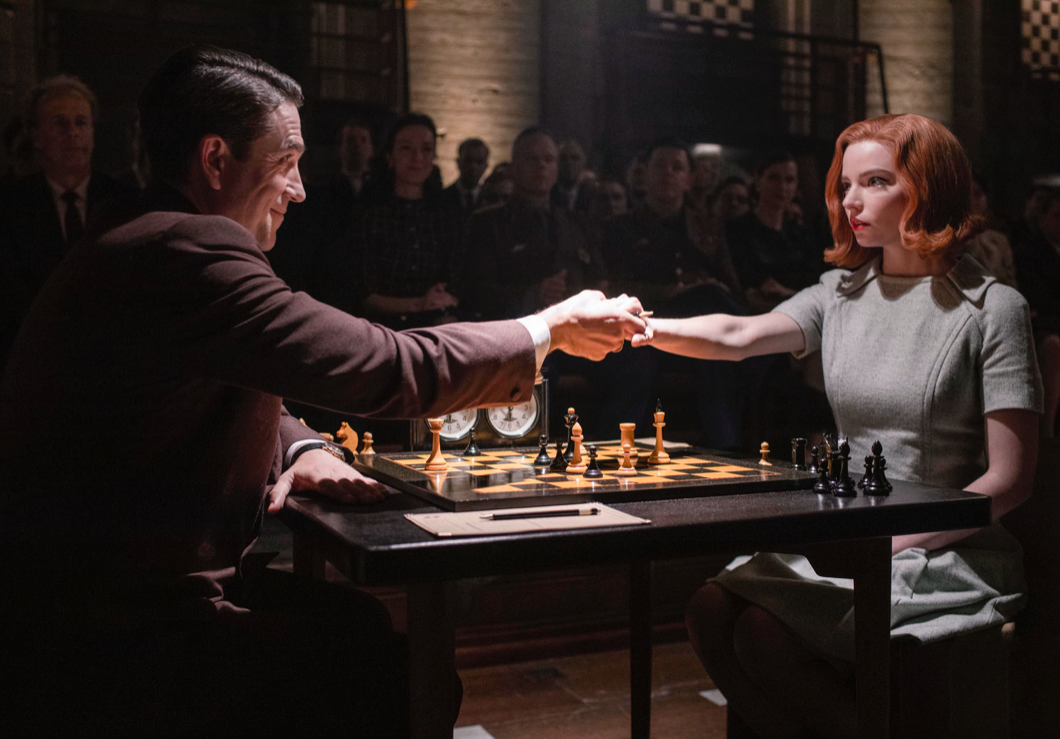When a young male friend offered to teach me chess last summer, I thought it sounded an exotic thing to learn at forty — and a feminist itch made me want to prove I could hold my own against the dorky boys. Perhaps one day — for the moment I am still pretty hopeless.
Radical gender imbalance continues to characterize the chess landscape. Gender ratios are slowly shifting among children as old beliefs about cognitive preference and ability are proved wrong, but top-level chess is still heavily male-dominated. At the very top, it is all male: there is only one woman in the top 120, Hou Yifan of China, ranked 115th. In other words, not all that much has changed since the era depicted in The Queen’s Gambit, Netflix’s hit 2020 series about troubled female prodigy Beth Harmon, played by Anya Taylor-Joy. The sight of a glamorous girl wiping the floor with crestfallen men was so electric that eBay chess-set sales rose by 215 percent, increasing, at one company, by 1000 percent, according to Vanity Fair.
It’s also why Judit Polgár, forty-six and one of the best players of all time, is so much more fascinating than her male counterparts. “There are men, there are women, and there is Judit Polgár,” the sexist saying went. At fifteen, Polgár became the youngest-ever grandmaster, beating even infamous misogynist Bobby Fischer’s record. She beat Garry Kasparov in 2002, sweet revenge against a man who was known to have claimed, “there is real chess and women’s chess… chess does not fit women properly.” Retired since 2014, she nonetheless trounced world number-one Magnus Carlsen, widely considered the best chess player the world has ever seen, in a casual game in Madrid in July 2022.
Polgár has a well-known family story. Her parents decided to homeschool their three daughters, focusing on chess, which they studied for hours a day. “Any healthy newborn,” said her teacher father László Polgár, could be turned into “a genius,” and he was vindicated beyond his wildest dreams: Judit and Susan both became teenage grandmasters and women’s world-number-ones, while Sofia, now an artist and teacher, was an international master. Klára Polgár, their mother, was also a teacher before quitting to help homeschool the girls and, though exacting and demanding, Polgár says her parents were “excellent teachers with good pedagogical skills.” Traveling the world and making money, chess allowed the family to operate as an enterprise and offered a life far beyond the ken of most people trapped in the Soviet bloc — opportunities to which “nothing can compare” Polgár tells me.
Polgár, who is married to a handsome veterinarian, has two teenage kids of her own, sixteen and eighteen, who “retired” from chess after second grade. Tight-lipped about Hungary’s divisive prime minister Viktor Orbán, the family lives in Budapest, where Polgár is a celebrity, focusing her post-retirement energies on her educational charity, the Judit Polgár Chess Foundation.
I first meet her in October at the Judit Polgár Chess Festival, at the splendid National Gallery in Budapest, where she is brusquely surveying a floor full of chess-enthusiast kids and their parents, educational dignitaries and chess celebrities. Among those sipping sparkling wine are Mikheil Chkhenkeli, the Georgian minister for education, who has just made chess compulsory for six-year-olds in Georgia, a country with an extraordinary record of female chess players, including Nona Gaprindashvili, the first woman to be made a grandmaster in 1978.
I also meet youthful looking Anish Giri, the world number seven; Dana Reizniece-Ozola, managing director of the International Chess Federation (FIDE) and former Latvian finance minister, also a grandmaster and a mother of four; and twenty-year-old Anna Cramling. Cramling is chess aristocracy — her mother is grandmaster Pia Cramling, one of the top female players in the world, and her father is the Spanish player Juan Manuel Bellón López. She is also supermodel-beautiful and has a huge online following. I see her constantly walking around being filmed for her Twitch stream, eventually making fast work of a long line of aspirational young male players, and even, with generosity and friendliness, me. (I freeze and blither; she beats me in two minutes.)
Then there is Polgár herself, with red nails, a sharply-tailored purple jacket and fishnet stockings barely visible between kitten heel and trouser cuff as she walks round the room simultaneously playing twenty or so opponents, ranging in this case from kindergartners to the Georgian minister to Hanif Qureshi, the genial head of the Pakistani chess federation. Polgár is relaxed, smiling, the queen of all she surveys, and easily wins against everyone bar Qureshi, against whom she draws. The chess festival is a success: glamorous, I surmise, in a way particular to the former Soviet bloc where, as Polgár tells me later, “every household had a chess board… we had a huge chess tradition.”
On a misty evening two days after the festival closed — with an “intimate” dinner for ninety-five at the Hilton which I was strictly warned off attending by Polgár’s gruffly rude, exhausted-looking assistant — I turn up at the offices of the Judit Polgár Foundation in a quiet road on the tranquil Buda side of the river. She is there alone and lets me in without fanfare, offering a glass of water before we sit down in her small office. I admire a glass case of exotic chess pieces behind her. They’re a selection from “my collection… pieces from India, from Africa, from different parts of the world, different materials. I go more for the visuals, the aesthetics, not the value,” she says.
I ask what board she uses “for fun,” but she answers a slightly different question, telling me she uses the classic tournament-style Staunton sets for “working.”
I ask again what she uses for “pleasure” and, still not seeming to grasp my assumption that she must still play for “fun,” she answers: “No, when I was training.” On my third attempt to clarify her “for fun” board choice — chess is a game, after all — she says: “I don’t work. I follow some games online, but I don’t play.” This seems sad, but at Polgár’s level, she says, “if you are not in everyday training” it does not “feel comfortable” to play the only people good enough to give you a decent game — masters and grandmasters — because every moment will be scrutinized.
The Queen’s Gambit changed everything for the game, unleashing armies of copycat chess players, and I am half expecting Polgár to roll her eyes at the “Netflix effect,” but she was delighted with it. “That was something very special, people were connecting me to The Queen’s Gambit series, even though it was a fiction, but the final part, where she was successful and beat the very best players, it resembled a little bit my story, and that I like very much,” she says. “Also it was extremely well done from different angles: it was very authentic, the chess part was at least 95 percent [right] from my perspective. And,” she adds somewhat amusingly, given that the heroine is a drug-and-booze addicted orphan with an attraction to Cold War Russia, “I was extremely happy that it was not about a crazy person, a lunatic, that it was not connected to politics. It was a very pure character movie, which was based on chess.” Polgár clarifies that Beth Harmon wasn’t “crazy”; her alcoholism and drug use stemmed from her experience being given tranquilizers in an orphanage and, we agreed, she is a nice person. She is not “very strange in [her] mind” as is often the case, says Polgár, in depictions of chess players.
It is fascinating to discuss The Queen’s Gambit — a series I devoured twice, most recently to garner some tips for my fledgling game — with someone who has lived that life, minus the drugs and booze. Chess may be primarily cerebral, but it is also embodied. As Polgár says, “If [you] never cooked and you go to the kitchen, you will see [the cook] always looking for something, by the speed, by the movements. It’s the same with chess, you made this move already a million times because you played so many games. Of course, you have already this movement, the way you see the board, because you did it so many times. You don’t know if you take that piece where you put it, do you put it into your pocket? Do you drop it because the clock is in the way?” Taylor-Joy’s task, in playing a champion chess player at different stages from awkward amateur to world champion, was akin to “memorizing some text in a language of which you have no idea.”
The Queen’s Gambit is as much about gender as it is about chess, of course, and Harmon’s sexuality is almost an extra character in the series. I ask Polgár what she makes of the sexual landscape in chess now, over half a century on. I am thinking in part of the beautiful, charming, tirelessly on-camera Anna Cramling: social media seems inexorably to have led to a focus on looks over chess. And social media is, predictably and somewhat dispiritingly, where young women in chess wield the most power.
“Basically the world is like that,” says Polgár with an air of weary pragmatism. “So what you can do is look at how you want to be treated, how you want to be looked at. Girls have to understand that’s how the world works. In my case… I practically played all my tournaments as the only girl with guys. So for me it was important that I don’t dress provocatively at all… wearing pants, jacket and usually a top which is not very open, because I feel that I want to show what’s going on [on] the board. I think there are a lot of small details if you want to protect yourself, but the world has its written and unwritten rules and preconceptions and stereotypes.”
She says “it’s a very complicated question” how to change this. “Some people say ‘I cannot do anything to help.’ I always say everybody can, but with a small step. Whenever you see a talented girl in STEM, say something nice to encourage and give her more confidence.”
There were no prominent chess foundations geared to encouraging girls when Polgár was cresting. Her mental strength in squaring up to — and eventually beating — Kasparov in 2002’s “Russia vs the Rest of the World” match is almost impossible to fathom. It was not her first match against Kasparov, and by then she was well-acquainted with “this very strong aura [of his]. You had the feeling when he came to the game that he wants to eat you up in [real] life, and then little by little I was able to overcome the challenge. I was prepared better, and I was getting over the fear, unconsciously… Then I developed a strategy and it worked — first it was two draws, and later I was able to beat him.”
The relationship between chess and technology has changed dramatically since Polgár began playing — everyone with a phone has access to more perfect knowledge of the game than a player could possibly achieve alone. We meet shortly after a scandal that gripped the chess world: world champion Magnus Carlsen made dramatic cheating accusations after he was defeated by American grandmaster Hans Niemann, whose ranking rose with suspicious speed at a relatively late age.
Niemann, who has confessed to cheating in the past, was said by some to have received tips via signals received through wireless anal beads, and is now suing Carlsen and others for defamation to the tune of $100 million. Once again, Polgár deflects: “It’s a complicated matter,” she says, in large part due to the absence of evidence in this case.
Despite the added risks of cheating, Polgár tends to see chess computation as an enhancement of the game. Alphazero, Google’s Deep Mind program designed to master chess, offers “some strategies and games where it shows some very interesting elements.” She points out that after 1997, when IBM’s Deep Blue beat Kasparov, “many people thought that the game [was] over. It’s the same thing [with modern engines]. Like, you know, you have bicycling and you have a car.”
Polgár may have stopped playing chess, but I want to know how her chess brain — filled for years before each match with a fat paper dossier’s worth of an opponent’s past moves — structures her thinking beyond the board. After all, my own frantic fumblings in chess are born in part of a desire to think more analytically about life.
“Most of the things I do, I slice it up or I break it down,” she says. “How do I deal with the unexpected situations? How much am I ready to make decisions? How do I deal with problems? How do I deal with things when nothing works out? How do I take a loss? How do I take a success and continue after that?”
She is increasingly interested in the power of chess beyond the limits of its sixty-four squares. Chess is cheap, accessible, democratic and absorbing, and Polgár points to the way it has the power to “heal communities” as well as to teach and delight. FIDE runs chess programs in prisons — to teach causality and consequences — and in refugee camps. Thanks in part to Polgár’s work, chess’s moment has arrived — and the endgame is nowhere in sight.
This article was originally published in The Spectator’s February 2023 World edition.

























